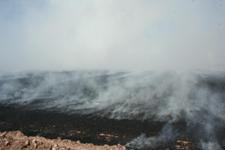
|
|
|
|

|
|||
|
|
|||
|
|
|||
|
It is necessary to remove wheat stubble from harvested fields. Although windrowing
and baling wheat straw has become increasingly popular, burning stubble to remove
it is still a common practice. The burning of wheat fields is a controversial practice
and various reasons are sometimes given for doing it. Weed and disease control are
sometimes cited as reasons for burning wheat fields. Although burning has some value
in controlling these pests, it is not enough to significantly affect either. Some
annual weed seeds that are within the top quarter inch are killed. It has little
effect on most of the others. Wheat is not one of the weedier crops grown in this
region and there are commonly not a lot of weeds left in the field at harvest. Some
weed seeds with hard seed coats actually germinate better after being burned. The
most common reason for burning wheat fields after harvest is to economically and
quickly remove stubble from the field to prepare for the next crop.

Burning Wheat Stubble
To contact Barry Tickes go to: btickes@ag.arizona.edu.
|
|||
| Back | |||
|
For questions or comments on any of the topics please contact Marco Pena at the Yuma Agricultural Center.
|
|||
|
Home |
Cotton | Veggies |
Forages | Grains
| Citrus |
Crop x Crop Insects | Diseases| Weeds | Pesticides | Economics | News | Weather | Research | Photos | Contacts | General Info. Copyright © 2001 University of Arizona, College of Agriculture and Life Sciences Webmaster: Al Fournier (acis@ag.arizona.edu) |
|||
